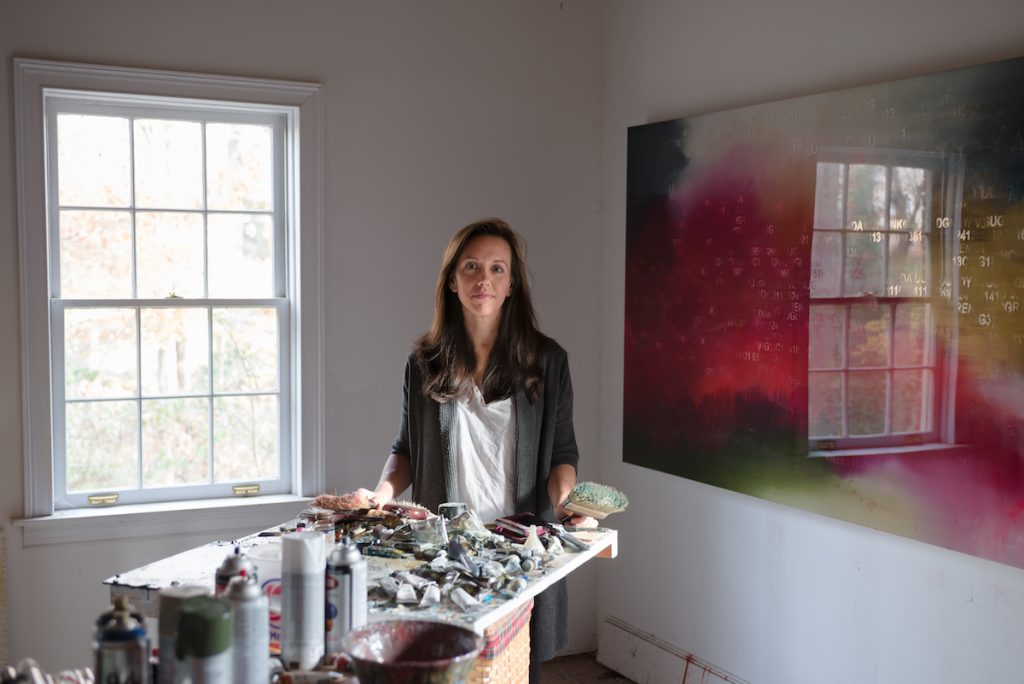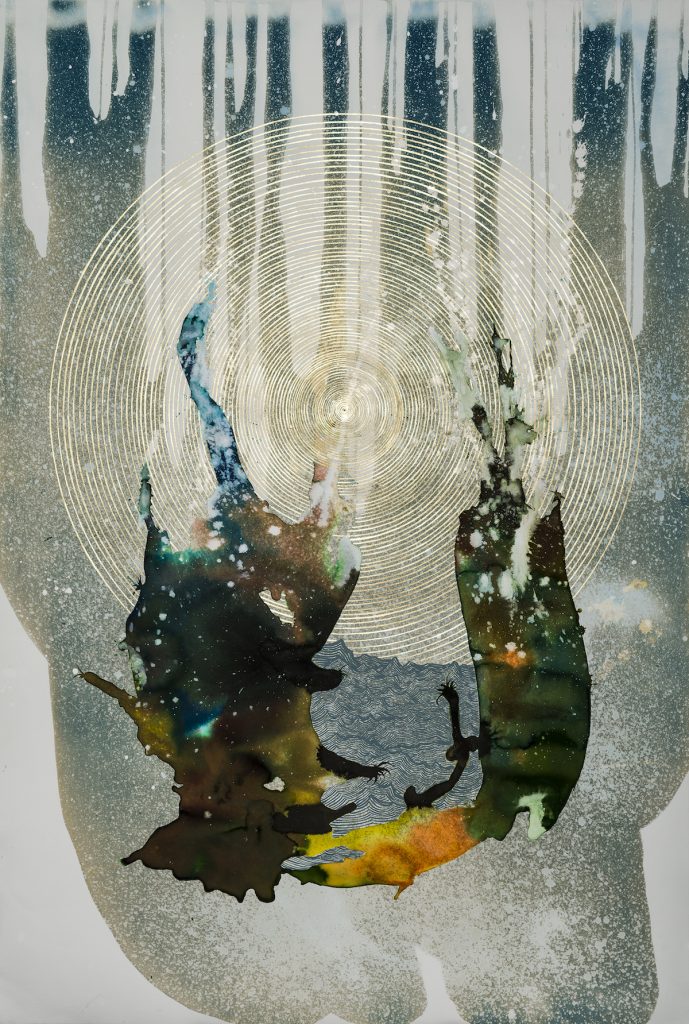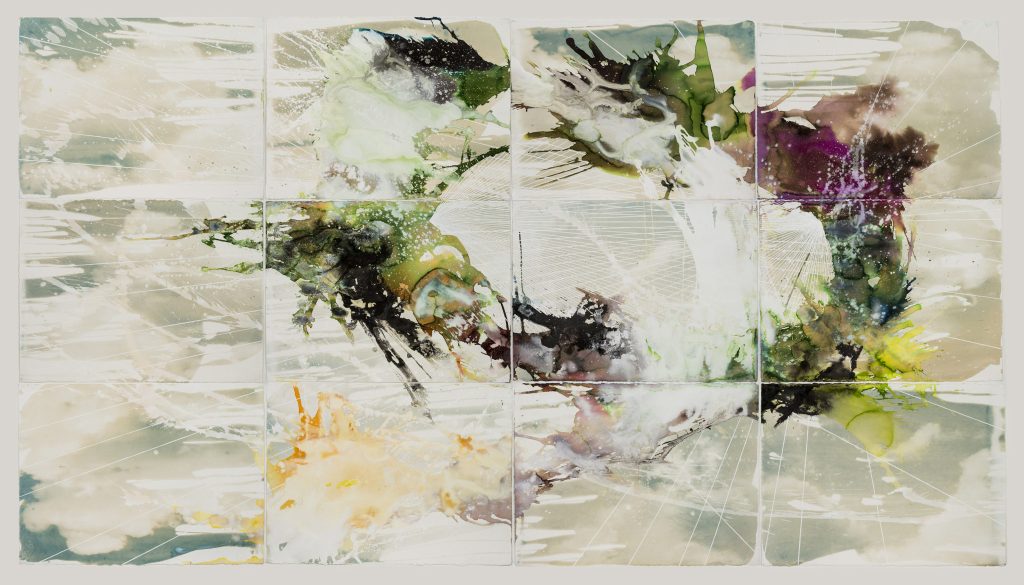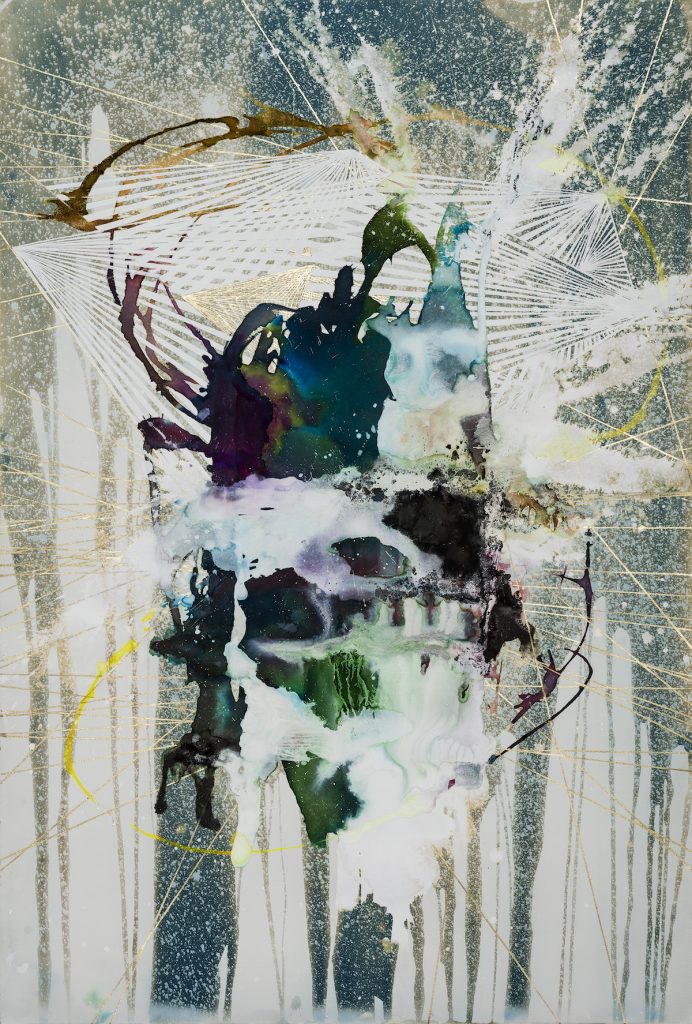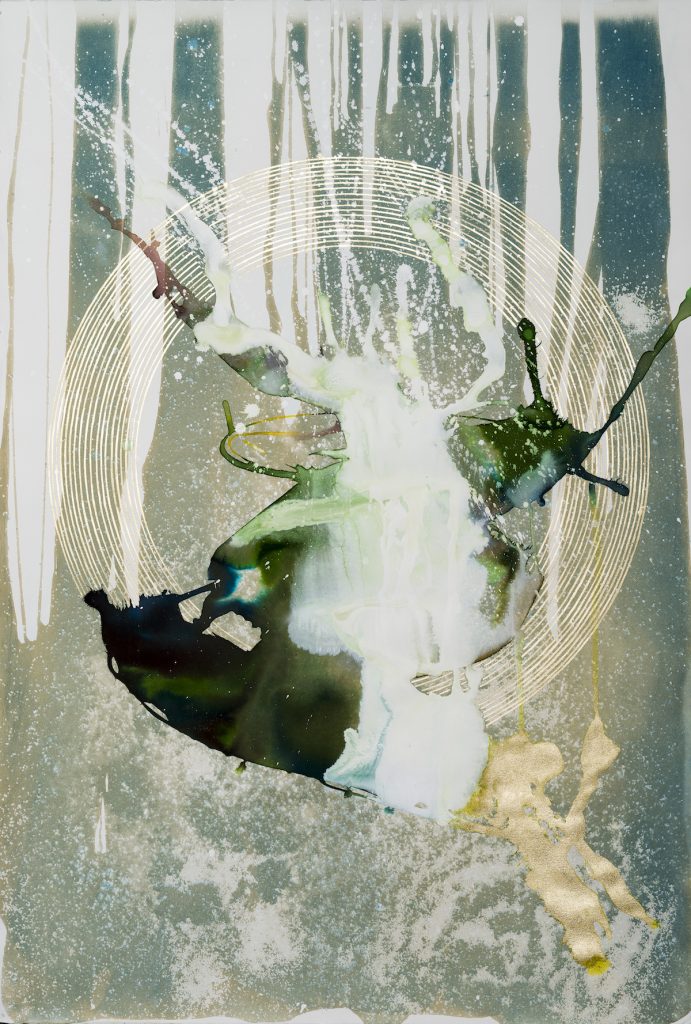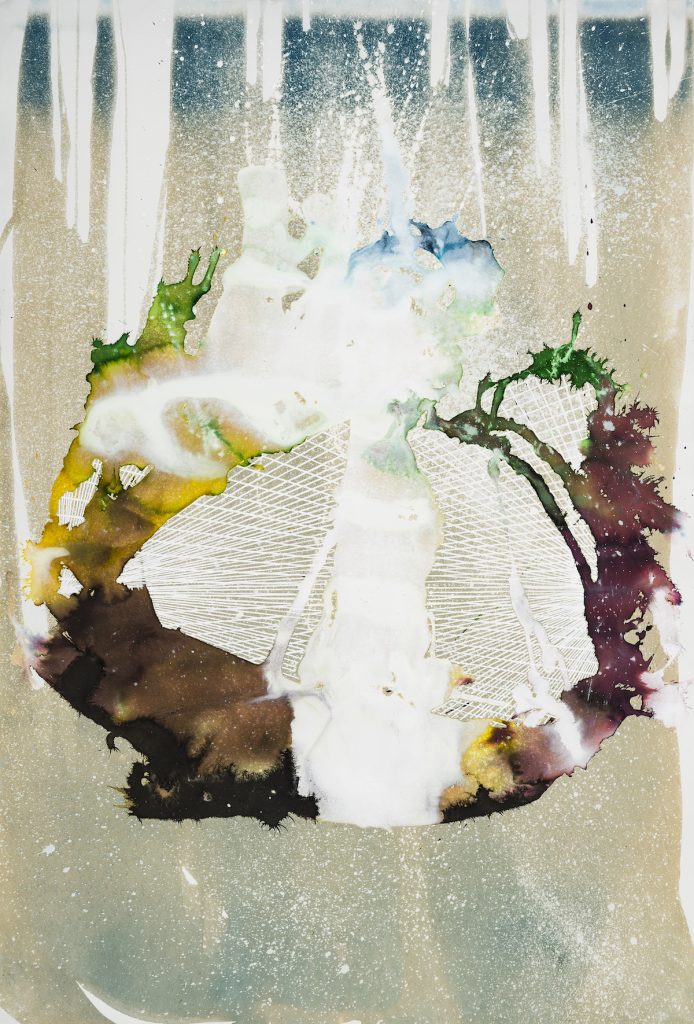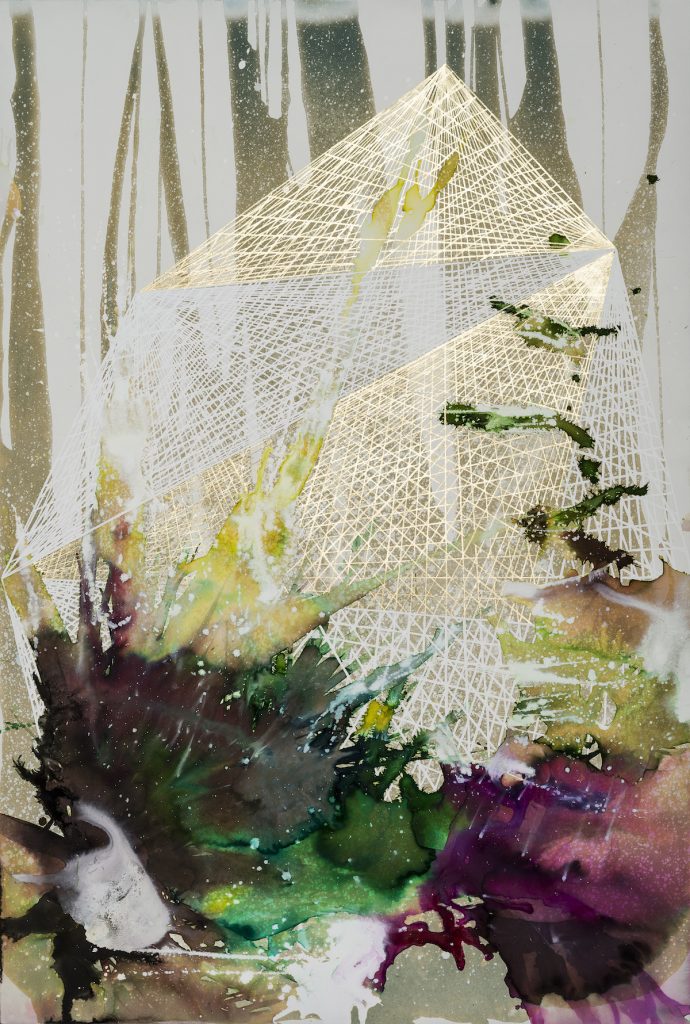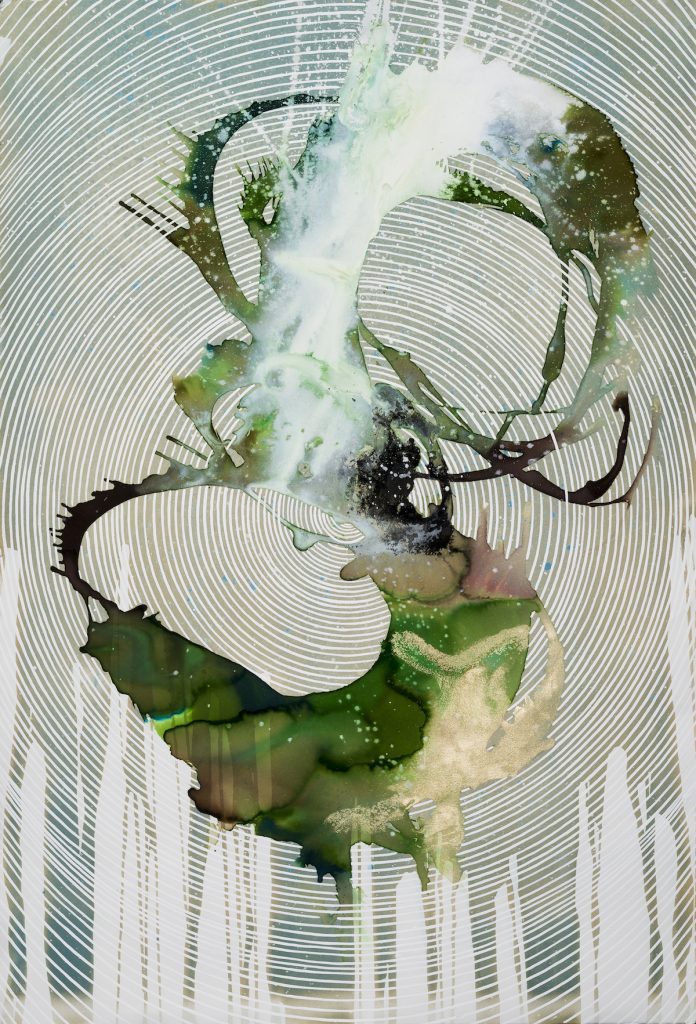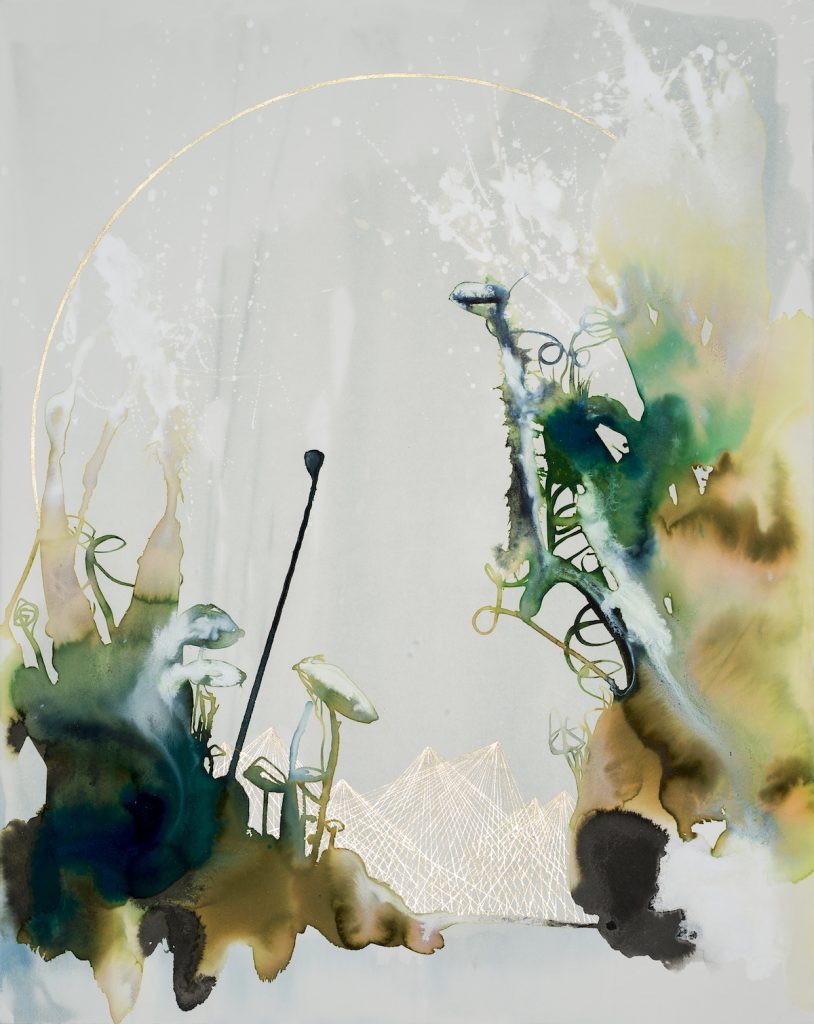Caroline Bullock Painter - Atlanta, USA
Can you briefly explain the process of cyanotype and how you use this technique?
Cyanotype is a photographic printing process that produces a cyan blue print through the use of light sensitive chemicals, UV light and either large format negatives or objects. The selected substrate (I use paper) is coated with the light sensitive solution, allowed to dry, then exposed to UV light with the negative and/or objects. I apply the liquid to the paper in random patterns and then expose the paper in sunlight using elements of nature such as sand, water and rocks to create the imagery or feeling I am trying to evoke. Once the image is exposed I rinse the paper, allow it to dry, and then tone the print with different methods to achieve the more muted, grey and golden tones I desire. For example, the blue/grey celestial background imagery you see in All Possible Worlds (Channel) is the cyanotype.
All Possible Worlds (Channel) Watercolour, ink, gouache and cyanotype on paper, 44 x 30 inches.
Your comment- “I am interested in how we attempt to create our perceived human reality with complex systems of mathematics, science and technology.” Discuss this in relation to your art.
I am interested in what lies beneath the surface of what we perceive to be reality. Mathematics is the language of nature, but it also distorts the perception of natural beauty and mystery. Technology allows us to explore the universe, but also encourages us to manipulate nature to our peril. The paintings I make attempt to address this conflict with processes that seem diametrically opposed: random and free flowing poured passages of paint and more planned intentional areas of geometric forms and shapes. My intent is to combine these two conflicting processes in a way that creates a unified representation of my vision of the universe.
All Possible Worlds, Watercolour, ink, gouache and cyanotype on paper, 66 x 120”.
You do a lot of work for large hotel chains; can you expand on how these commissions came about?
I sell my work through a gallery and a variety of art consultants. Many years ago, various art consultants from different art consulting firms approached me after seeing my work in some group shows and it’s evolved from there. Some consultants work for private collectors or corporations and others primarily represent the hospitality industry. The consultants that work for the hospitality industry are almost always seeking a certain size of work that demands commissions or reproductions. For many years I was producing only original commissioned work based off of existing work that had either sold or wasn’t the size a project demanded. More recently, and I suspect due to the rise and capabilities of digital technology, I am primarily selling high volume reproductions (giclees) of my work to the hospitality industry or am contracted to produce an original that can then be scanned and printed at a desired scale.
All Possible Worlds (Tempest) Watercolour, ink, gouache and cyanotype on paper, 44 x 30 inches.
Often your work has multiple circles, expand on this aspect.
I use the circle in my work primarily for its extensive symbology. In my work the circle can represent portals or it can symbolize the infinite nature of the universe. Concentric circles in my work can symbolize the vibrational pattern of all that we see and cannot see in the universe.
All Possible Worlds (Faunus), Watercolour, ink, gouache and cyanotype on paper, 44 x 30 inches.
Expand on the series of work All Possible Worlds
My most recent work is inspired by my interest in the multiverse or “many-worlds” theory of quantum mechanics. The idea that the 3-dimensional world may be just an illusion resonates with me as a painter who makes paintings that are, in their very essence, nothing but an illusion. The paintings in the All Possible Worlds series juxtapose multiple mediums, that rely on both randomness and intention, with more direct elements such as photography and mechanical, geometric drawings. Inks and watercolors blend and react, creating forms that become almost organic in nature— flowing, bursting, seething, or vibrating—while the geometric drawings, intertwining amongst the ink pools, connote the structure as well as the energy of the forms, creating new and different worlds unto themselves. The process often seems in conflict, but my intent is to bridge these conflicts in a method that is primarily unexpected and always enlightening.
All Possible Worlds (Lacuna) Watercolour, ink, gouache and cyanotype on paper, 44 x 30 inches.
Take ‘All Possible Worlds – Conservatory’ and discuss the number of layers that this one artwork has. Also discuss the importance of layering to your work.
This piece consists of several layers of media like the rest of the pieces in the series: cyanotype, watercolor washes, ink washes, graphite drawing and gouache detail work. The cyanotype is the first layer and this forms the background imagery of the piece. Next I lay down areas of water and watercolor washes to form the shape I am inspired by or desire. I then work with the gouache and ink in different ways to see how they flow together and form new colors or react and create unexpected but exciting passages of shape and color. Lastly, I sketch in the geometric forms and paint these with the gouache.
I don’t really think about layering in my work although generally multiple layers create more depth and I think this often makes the piece stronger visually and conceptually. That said, some pieces are created rather quickly with only one ink or watercolor passage. It’s a delicate balancing act of how to know when to stop and I think most artists can relate to this challenge.
All Possible Worlds (Conservatory) Watercolour, ink, gouache and cyanotype on paper, 44 x 30 inches.
What is the drying process involved and is buckling a problem with the paper?
Watercolors and inks dry within hours which is why I enjoy using them as it keeps the work fresh. Buckling isn’t really an issue for me as I use a medium weight printmaking paper for my pieces primarily because I need a paper that will stand up to the cyanotype process which involves multiple washings in water.
What type of paper do you use and is the weight or other factors in your paper choice?
I use Rives BFK printmaking papers not only because they’re beautiful, but also for their ability to withstand multiple washings during the cyanotype process. I’m also looking for a specific “bleed” effect of my watercolors and inks and after much trial and error this paper seems to suit my needs best.
All Possible Worlds (Supernova) Watercolour, ink, gouache and cyanotype on paper, 44 x 30 inches.
‘All Possible Worlds’- Swamplands gives such a feeling of the blending of man and nature, discuss.
This was one of my first pieces in the All Possible Worlds series. I wanted to create a piece that reflected peering through a portal or looking glass into another world. I had a vision of the beginning of time and creation arising out of the primordial muck, such as swamps and marshes that are so teeming with life, and then exploding into the atmosphere. The geometric shapes in the background reflect my interest in the underlying mathematical, geometric structure of nature and these shapes could be read as representations of mountains or hills in the distance.
All Possible Worlds (Swamplands) Watercolour, ink, gouache and cyanotype on paper, 44 x 30 inches.
You worked on your ‘All Possible Worlds’ series in 2017 what does 2018 hold?
I plan to continue to work with this concept in 2018 and will also be experimenting with different mediums and substrates. I want to try and create some large canvas pieces in addition to the works on paper. The work and challenge there will be experimenting with new mediums and how these translate to canvas. Some sculpture isn’t out of the question either.
Contact details:
Caroline Bullock
Caroline Bullock, Atlanta, USA
Interview by Deborah Blakeley, February 2018
Think a colleague or friend could benefit from this interview?
Knowledge is one of the biggest assets in any business. So why not forward this on to your friends and colleagues so they too can start taking advantage of the insightful information the artist has given?
Other artists you may be interested in:


